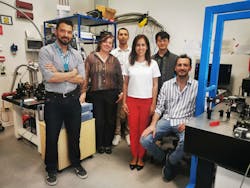Topological insulators unlock previously inaccessible regions of electromagnetic spectrum
In a breakthrough for high-harmonic generation (HHG), a team of researchers led by Professor Miriam Serena Vitiello and her group at CNR-Institute of Nanoscience in Italy demonstrated topological insulators make it possible to reach previously inaccessible regions of the electromagnetic spectrum.
HHG is a way to convert light into higher frequencies. But accessing terahertz frequencies via HHG is a challenge, thanks to most materials’ symmetrical nature. Graphene, which shows promise in so many ways, produces only “odd harmonics” (frequencies that are odd multiples of the original light signal). “Even harmonics” has remained out of reach—until now.
Vitiello decided to explore the potential of topological insulators. “These unique materials act as insulators internally but conduct electricity on their surfaces—and exhibit unusual quantum behaviors,” she says. “My idea was to try to overcome the lack of miniaturized light emission technologies at frequencies between 6.5 THz and 10 THz by combining a material platform with metamaterials (artificial materials that can be customized) to promote nonlinear optical effects and generated light at the frequency of light emission playing with a set of ‘controllable’ parameters.”
Nanostructures, split ring resonators, bismuth selenide, and metamaterials
How does Vitiello’s team’s method work? The basic concept is to use an array of nanostructures and split ring resonators, and integrate them with thin layers of topological insulator materials like bismuth selenide (Bi2Se3) and van der Waals heterostructures (artificial materials created via stacking different 2D atomic layers, which are held together by weak van der Waals forces). These nanostructures significantly amplify the light impinging on it, optically, and enable observation of high-harmonic light generation at terahertz frequencies.
“Frequency up-conversion occurs at two or three times the frequency of the incoming light beam, which provides clear evidence of how the material’s internal symmetry and asymmetrical surface contribute to light generation,” explains Vitiello. “Our work marks the first experimental validations of topological effects influencing harmonic behavior within the terahertz range.”
Everything about this research “was very surprising and exciting,” says Vitiello, who designed the idea from scratch on paper during a Saturday afternoon while in the garden with her kids. “When my team and I fabricated the structures and ran the experiment, I was not expecting it to work on the first attempt,” she says. “It made my group extremely happy.”
Their work included several sets of simulations to design a suitable resonant metamaterial pattern for engineering the array pitch and, more importantly, to simulate the light-induced nonlinear optical response within the challenging terahertz frequency range and the predicted conversion efficiencies.
“There are certainly still many technical challenges to overcome, including the lack of on-chip integration between the metamaterial pattern and the pumping laser source—a quantum cascade laser—and the possibility to enhance the optical power generated to milliwatt levels,” says Vitiello.
Novel approach enables exploring symmetry and quantum states
What does this work mean for the photonics and quantum realms? “Our discovery demonstrates a novel approach for studying the intricate relationship between symmetry, quantum states, and light-matter interactions at the nanoscale,” says Vitiello.
As demand for smaller, faster, more efficient technologies continues, the team’s advance showcases the potential of quantum materials to drive real-world innovation. Its potential applications include tunable terahertz light sources powered via optical methods, which may revolutionize quantum computing, high-speed comms, and medical imaging.
The team is already busy working on what’s next: “A revolutionary evolution of this discovery,” says Vitiello. As for a timeline, it’s likely less than a year out.
FURTHER READING
A. Di Gaspare et al., Light Sci. Appl., 14, 337 (2025); https://doi.org/10.1038/s41377-025-01847-5.
About the Author
Sally Cole Johnson
Editor in Chief
Sally Cole Johnson, Laser Focus World’s editor in chief, is a science and technology journalist who specializes in physics and semiconductors.

